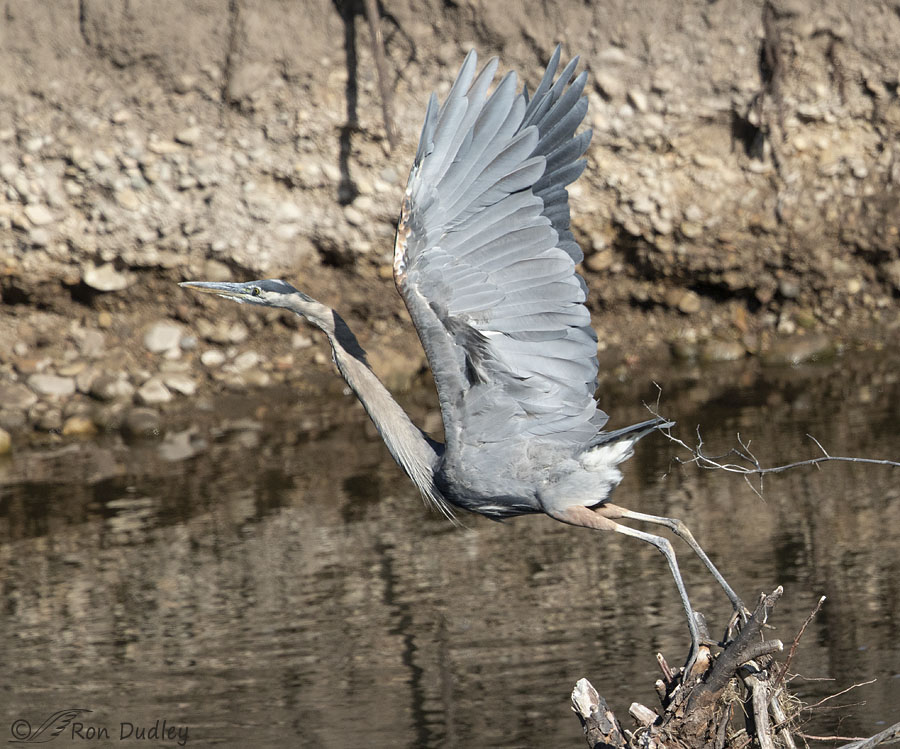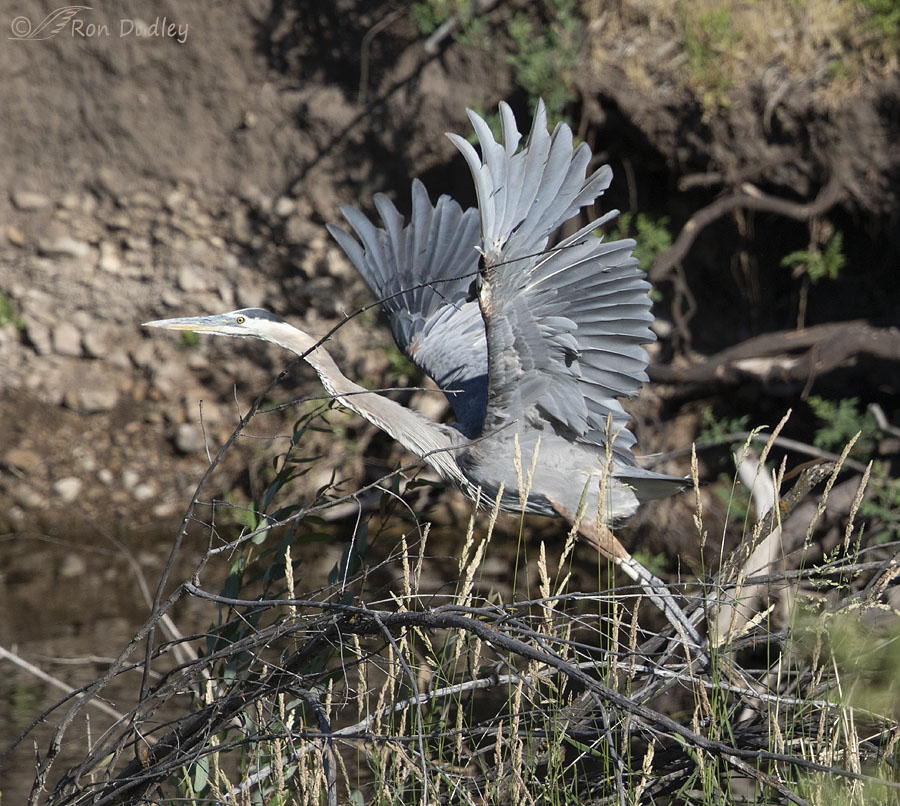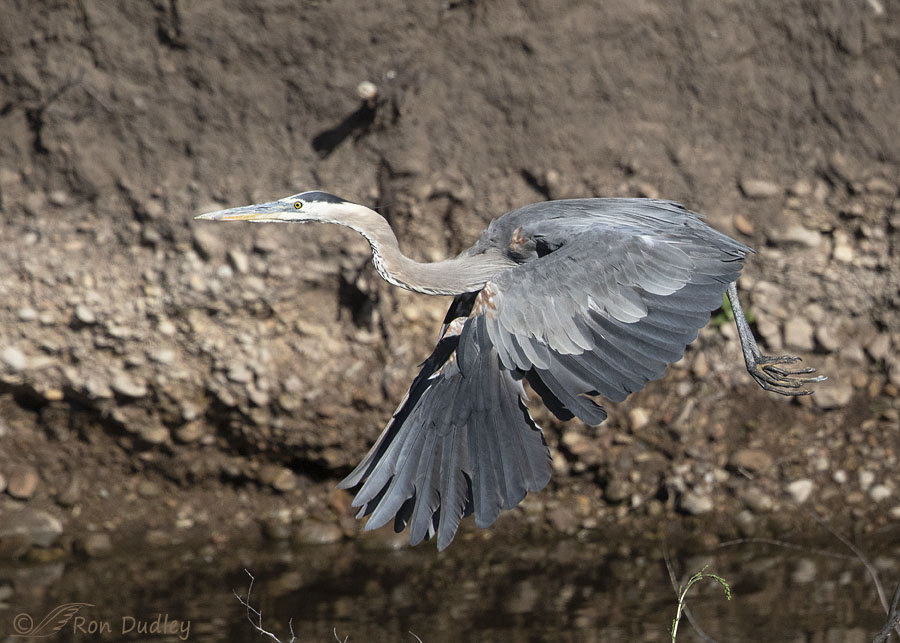These two herons looked identical to me, until they took off.

1/4000, f/6.3, ISO 800, Canon 7D Mark II, Canon EF 500mm f/4L IS II USM + EF 1.4 III Extender, not baited, set up or called in
Both birds were perched on a creek edge and within a few feet of each other in the mountains yesterday morning. I had the clearest look at this one so I trained my lens in it and hoped it would take off. It obliged me in that regard but I was disappointed that it was looking slightly away from me as it launched.
Notice that, to my eye at least, this bird has no significant molting going in in its flight feathers. This species has a very complex molt cycle but it appears to me that its flight feathers are complete at the moment and in pretty good shape.

1/4000, f/6.3, ISO 800, Canon 7D Mark II, Canon EF 500mm f/4L IS II USM + EF 1.4 III Extender, not baited, set up or called in
That bird’s buddy, perhaps 10-15′ to the right of where the first bird had been perched, waited less than thirty seconds before it took off and followed the other heron. Again I was disappointed, this time by all the clutter in front of the bird, but I still think the photo is interesting for a reason you’ve probably already noticed.
Just look how ratty many of this bird’s flight feathers are. In contrast to the previous heron this bird is in the midst of a substantial molt. I remember that when I first started photographing birds I thought if I found a molting bird it meant that all other birds of the same species in that area must be molting too. There are too many variables to go into here but that’s not necessarily the case.
I got some other shots I like of both birds in flight but for now I’ll focus on one more photo of this “ratty” heron.

1/8000, f/6.3, ISO 800, Canon 7D Mark II, Canon EF 500mm f/4L IS II USM + EF 1.4 III Extender, not baited, set up or called in
Four frames later in the burst I got this shot of the heron in flight with the eroded creek bed in the background.
Personally I think this is a pretty neat shot for several reasons but one of them jumps out at me. Can you guess what grabs my eye in particular? Keep in mind that I can be a little quirky when it comes to my photos…
Just look how symmetrical this bird’s molt pattern is. I happened to time this shot just right so we can see through the “molt gaps” in both wings to the eroded creek bed behind the bird. Most bird species (there are exceptions – penguins and some others) molt their flight feathers symmetrically and gradually so they can more easily maintain balance in flight.
Anyway, timing this shot as I did tickles me so I decided to include it. At this stage of my life I’m probably easily tickled.
Ron


Before reading the comments, my guess is how the wing feathers part at the same spot on each side making a pass-through for the eye. 😀
Wow, that is very noticeable! a day in the life of a bird, well-captured!
Fantastic shot of the symmetrical molt (or is it moult?). I have been observing GBH’s quite a bit this year. A weird experience is when looking up at nests with chicks in them. They can have their beaks raised at quite an angle and because of the angle of their eyes they look like they are staring straight down at the observer on the ground. Your first photo kind of shows how there eyes are angled.
Thanks, Lyle. “Moult” is British English and “molt” is American English.
Yes, quite a few photos I’ve seen of various heron species taken from below show the effect you describe.
That is a serious bad feather day. My anthromorphising self can only think that it would make flight (and particularly take-off) hard work. And how fascinating that they moult in such an ‘orderly’ way.
How long does the average moult last? Do you know?
No, I don’t know, EC. But I’m sure it varies a lot for a variety of reasons.
Beautiful and VERY interesting on the moult pattern! Love GBH! About the only time we see them is when Belt Creek is drying up and they’re working what puddles are left – VERY spooky….. The hawk certainly was a mess! :O A dozen or so mostly grown merganzers were making their way up the creek last evening – fund to watch – don’t dare move to get a camera or they’d be gone so just watched……:) Found out what severe vertigo was about this morning – scary and NOT something I hope for a repeat of… 🙁
Geez. Vertigo is AWFUL, Judy. I’ve never dealt with it but friends have. I sure as hell hope it doesn’t come back!
Good comparison of birds in and out of molt. Not many know about the symmetrical molting strategy. And I also like that third image with the “suspended” heron.
Wally, “Suspended” is how I saw the bird when I first looked at that last photo and now it won’t leave me…
Wonderful flight capture. The blues shades are lovely. It has adult coloring on the body but the head looks juvenile to me. I think it is the beak color and the color around the eye. It could just be the light or a muddy beak.
Thanks, April. I thought both birds looked like adults but I was far from sure.
Those are nice pictures of he GBH. Get to see them up pretty close for a change. Have a few of them that are in the Big Horn Mountains during the summer and then back in Sheridan area later. They are always far away from me, so nice to see them up close. We even had a statue of one at the front door of the Senior Center aka now called the Hub.( Don’t like the name at all.) Any way thanks for the insight on them.
It’s funny about this species, Trudy. In some areas they’re extremely approachable but in others they’re shy as the dickens. Thanks, Trudy.
Great and interesting shots Ron! What a refined eye and skills you have!
Charlotte
Thanks very much, Charlotte, deserved or not…
You weren’t kidding in yesterday’s reply! As Dick would say, VBG!!! 😃 One of my very favorite birds and two shots of my favorite “wing fling” position. Heckyeah, it’s gonna be a good day! I also noticed the peekaboo background in the molt gap and thought that was pretty slick, so I guess we’re both ticklish in the same spot. 😜
I was hoping you’d see this, Marty. Tickle, tickle…
Tee hee hee. 😂
I’m glad that you mentioned the symmetry of the molting; as I looked at the photograph, I wondered if the bird has to go thru a period of being grounded by all-over feather loss,
or if it occurs only a few feathers at a time, retaining the ability to fly ?
Kris, some bird species are “grounded” during molt (geese for example) but most of them, herons included, molt gradually enough that they don’t lose the ability. That’s not to say that flight isn’t more difficult for some of them during molting. I once photographed a molting Red-tailed Hawk that amazed me that it could even get airborne (although it’s possible there was more going on with this bird than just molt). See link below:
https://www.featheredphotography.com/blog/2013/04/15/how-can-this-hawk-even-fly/
The bird is interesting, but so is the geology of the bank behind it. The layers make it seem there was a raging flow at a river delta that carried big rocks and dark mud for a long time. Then big rocks in lighter mud, likely from a different area. And then just the fine mud, likely as part of a flow too slow to carry big rocks. You probably know more about the geological history of the area than I can tell.
I’m glad you found the geology interesting, Nancy. I’m a bit of a geology nut myself. I’m fairly familiar with the geology of my general area (Great Basin, Great Salt Lake, etc.) but I have no specific geological knowledge of this particular canyon.
Very interesting Ron. Really like the 3rd in-flight photo. In the 2nd photo what is the whitish object slight to the right of the Heron? Is that another Heron in the background or something else?
Thanks, Everett. I think that’s just an out of focus, broken and sun-bleached branch.
Interesting shots. The first one appears to me to have two new primary feathers that aren’t completely extended. One obvious and another hiding behind #4 I think or its an optical illusion. The last shot is the most interesting to me, the fact that the molt is the same on both wings. Makes sense that it would be done like that, but an image like this is proof positive.
Thanks for sharing.
Thanks, Dick. I’m surprised by how much I like that last shot. To me it looks like the bird is suspended in air and not moving, almost like it’s hanging from invisible strings or wires and if you cut them the heron would plop straight down into the water.